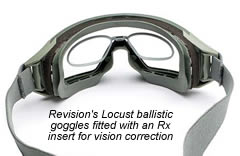Soldiers wearing prescription lenses are usually become more problematic with protective eyewear, due to the limited options and discomfort associated with wearing goggles and glasses (contact lenses are prohibited in theater). This problem has been solved partially, with the use of ‘optical inserts’ with some of the protective eyewear, however, these inserts may cause even more problems in combat situations, even when they are worn with ballistic eyewear. While the goggles themselves can survive an impact or even endure an IED blast, if the optical insert is not designed to endure the impact, it can shatter and cause even more damage, as it is located closer to the eye.
For an increasing number of service members, laser eye surgery is not a cosmetic nor convenience issue. It is all about saving lives on the battlefield. The military has come a long way since 2000, when DoD first began allowing people with two common forms of laser eye surgery to enter the military with a medical waiver. People who had corrective eye surgery were previously ineligible for military service. That move was based largely on groundwork laid by the Navy. Naval Medical Center San Diego launched the military’s first refractive-surgery program in 1993, primarily serving Navy SEALS who had problems losing contacts or eyeglasses while parachuting or in the water.
Laser refractive surgery is now permitted for all warfare communities within the Navy and Marine Corps. The Air Force Warfighter Photorefractive Keratectomy Program went active at the end of 2001. The Army’s first Warfighter Refractive Eye Clinic, at Fort Bragg, opened its doors in May 2000. The most common types of laser eye surgery offered are photorefractive keratectomy, or PRK, and laser in-situ keratomileusis, often referred to as LASIK. In the past some 80 percent of the patients chose PRK, a procedure that requires a slightly longer healing time but poses reduced risk of complication. In early November 2006 the US Navy allowed, for the first time, to four of its aviators to undergo LASIK surgery with the IntraLase method. Although LASIK is not yet officially approved in the U.S. military aviation community, this is a first step in that direction. In the past, concern about the harsh aviation environment has prevented the use of LASIK as a method to treat the eyes of military pilots, Dr Dello Russo explained. High altitude, dry air, and wind blast are just some of the extreme conditions that these pilots encounter, but years of LASIK trials on non-aviation personnel encouraged the Bureau of Naval Medicine.
In this series Defense Update covers the following topics:
- Body Armor Suites
- Ergonomic Body Armor Designs
- Ballistic Helmets
- Physiological and Physical Challenge of Body Armor
- Eyewear Protection for the Warfighter
- Tactical Benefits of Laser Eye Surgery (LASIK / PRK)
- Cooling with Phase Change Materials (PCM)
- Improving the Combat Survival Rate Among the Wounded
- Load Carrying Systems for the Infantry
















